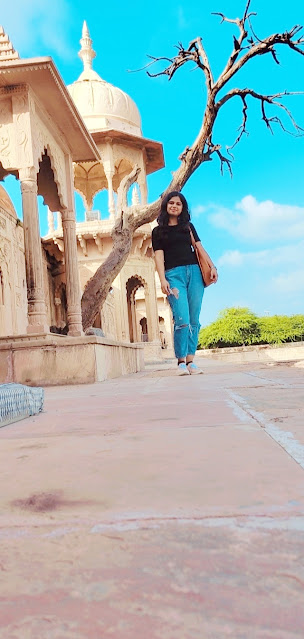When
was the first time you heard about Mathura? It was probably in your childhood when you were reading one of those iconic Amar Chitra Katha books,
depicting the stories of Lord Krishna. Or it was your grandmother, who told you
bedtime stories about little Krishna and his endearing pranks? In all those
stories, a name came up – Mathura, his birthplace. Back then, Mathura
never felt like a place to you; it, on the other hand, felt like a character,
living and breathing and full of life.
Mathura boasts a rich cultural heritage that is woven through hundreds of legends and myths. It is undoubtedly regarded as one of the
seven holy cities by Hindus all over India. Even in this modern age, the charm
of Mathura continues to lure visitors from all parts of the country and beyond.
And what makes this sacred city a hot favorite among tourists? The answer is
pretty simple – the enticing milieu of sacred temples, religious structures,
landmark monuments, and serene ghats lend Mathura a
surreal beauty that is hard to find in your regular tourist destinations.
One such beautiful place
is Kusum Sarovar.
Kusum Sarovar is a
sacred water reservoir surrounded by a medieval sand monument.
It is located between the Manasi Ganga and Radha
Kund on the famous Govardhan Hill in the Mathura district of Uttar Pradesh,
India.
Kusum Sarovar is acknowledged as one of the holy
sites where Hindu deities Radha and Krishna performed their rituals. Kusum
Sarovar has Narada Kund, where Bhakti Sutra verses were written by Narada, and
the Shri Radha Vana Bihari Temple in the vicinity.
Historical belief
Kusum Sarovar was a natural pond until 1675 when it was
professionally built by Orchha's monarch, Veer Singh Deo. In 1735, King
Veer Singh of Bundelkhand, Madhya Pradesh, ordered the restoration of this
place. The area around this place was rebuilt by King Suraj Mal. In
commemorating his father Raja Suraj Mal, King Jawahar Singh of Bharatpur
erected a sandstone monument in the backdrop of Kusum Sarovar in the
mid-eighteenth century.
"A Handbook for Visitors to Agra and Its Neighbourhood,"
by Henry George Keene, published in 1878, describes Kusum Sarovar.
"On
every side of the reservoir that fronts it, handsome landing-places run out
into the still water with deep and wide staircases between; a venerable banyan
tree shades the south side, and sends its pendant shoots towards the water… The
spot is singular in its repose, silence, and irregular charms."
— Henry Geroge Keene
The most divine love story-
Radha Krishna Legend
Kusum Sarovar dates back to the era of Radha Krishna. It is a site
surrounded by flowers and Kadamb trees, as the name says. Radha is supposed to
have come here under the guise of picking flowers for her companions, but
instead met Krishna and had lively chats with him. According to
mythology, Radha's dress became trapped in thorns while collecting flowers, and
Krishna, dressed as a gardener, came to Radharani's rescue and freed her dress
from the thorns. On this historic spot, Krishna is reportedly said to have
played hide-and-seek with his companions and collected flowers for Radha's
garlands.
Architecture
Kusum Sarovar Ghat
Kusum Sarovar Ghat
is a 450- foot- long, 60- foot- deep tank in Kusum Sarovar. The pond’s ghats
(banks) have a Rajasthani design. A series of steps climb upward from all four
corners of the Kusum Sarovar to the historical edifice built by King Jawahar
Singh. Around 60 meters deep are the arcade walls that surround the pond. The
pond, filled with emerald green water, is surrounded on all sides by a
forest that offers a multitude of flowers.
Monumental
structure
The historical monument was built in commemoration of
King Jawahar Singh's parents. The main tomb, dedicated to King Suraj Mal, is
positioned in the center of the colossal edifice and covers an area of 57
square feet. There are two other historical constructions on both sides of this
tomb that are considerably lesser in size. These tombs were built in honor of
King Suraj Mall's two queens, Kishori and Hansiya.
The whole structure is supported by a 460-foot-long terrace
and a pavilion that serves as a protective cover for both corners of the
structure. Inside the tomb, the architecture and sculpture are in the
perforated stone style. The cenotaphs' ceilings are embellished with
magnificent murals depicting Radha Krishna's divine pastimes and happenings at Maharajas
Suraj Mal's court. The edifice also includes a copy of Lord Krishna and Radha's
lotus feet.
Why should you visit Kusum Sarovar?
Kusum Sarovar is a popular tourist destination in the Braj region. Visitors travel across the state to see the majestic structures that enclose the Sarovar (pond) and the exquisite murals representing Krishna's life and his adventures with Radha. Radha Krishna is said to have performed numerous pastimes here. During his time in Vrindavan, Chaitanya Mahaprabhu, a Vaishnava saint and a renowned devotee of Krishna, liked to visit this pond. Kusum Sarovar was also known as Suman Sarovar during the reign of Chaitanya Mahaprabhu. It is stated that anyone who bathes in the Kusuma Sarovara pond will gain pure Krishna's love.
Visiting
time
Everyday
- 6:00 AM to 6:00 PM.














